Modeling Parametric Forecasts of Solar Energy over Time in the Mid-North Area of Mozambique
Abstract
1. Introduction
2. Materials and Methods
2.1. Data Collection and Processing
2.2. Study Area
2.3. Solar Radiation Path Above the Surface of the Earth
2.4. Review of Previous Works
2.5. Experimental Procedure
3. Results
3.1. Evolution of the Solar Energy Characteristics in Terms of Space and Time
3.1.1. Examination of Model Performance Inaccuracies
3.1.2. Examination of the Forecasted Solar Energy at Each Measuring Location
At the North Region
At Mid Region
3.2. Evaluation of the Intensity of the Movement of the Clear-Sky Index
3.3. Estimates of the Clear-Sky Index’s Deviation and Growth for Every Province
4. Discussion
5. Conclusions
6. Patents
Author Contributions
Funding
Institutional Review Board Statement
Informed Consent Statement
Data Availability Statement
Acknowledgments
Conflicts of Interest
References
- Iqbal, M. An Introduction to Solar Radiation; Academic Press: Toronto, ON, Canada; New York, NY, USA, 1983. [Google Scholar]
- Mucomole, F.V.; Silva, C.A.S.; Magaia, L.L. A Systematic Review on the Accessibility of Spatial and Temporal Variability of Solar Energy Availability on a Short Scale Measurement. Am. J. Energy Nat. Resour. 2024, 3, 60–85. [Google Scholar] [CrossRef]
- Duffie, J.A.; Beckman, W.A. Solar Engineering of Thermal Processes; Wiley: New York, NY, USA, 1980. [Google Scholar]
- Babar, B.; Luppino, L.T.; Boström, T.; Anfinsen, S.N. Random forest regression for improved mapping of solar irradiance at high latitudes. Sol. Energy 2020, 198, 81–92. [Google Scholar] [CrossRef]
- Hossain, R.; Ooa, A.M.T.; Alia, A.B.M.S. Historical Weather Data Supported Hybrid Renewable Energy Forecasting using Artificial Neural Network (ANN). Energy Procedia 2012, 14, 1035–1040. [Google Scholar] [CrossRef]
- Tsai, S.-B.; Xue, Y.; Zhang, J.; Chen, Q.; Liu, Y.; Zhou, J.; Dong, W. Models for forecasting growth trends in renewable energy. Renew. Sustain. Energy Rev. 2017, 77, 1169–1178. [Google Scholar] [CrossRef]
- Tso, G.K.F.; Yau, K.K.W. Predicting electricity energy consumption: A comparison of regression analysis, decision tree and neural networks. Energy 2007, 32, 1761–1768. [Google Scholar] [CrossRef]
- Mucomole, F.V.; Silva, C.A.S.; Magaia, L.L. Temporal Variability of Solar Energy Availability in the Conditions of the Southern Region of Mozambique. Am. J. Energy Nat. Resour. 2023, 2, 27–50. [Google Scholar] [CrossRef]
- Abolarin, O.E.; Akinola, L.S.; Adeyefa, E.O.; Ogunware, B.G. Implicit hybrid block methods for solving second, third and fourth orders ordinary differential equations directly. Ital. J. Pure Appl. Math. 2022, 48, 1–21. [Google Scholar]
- IEA; IRENA; UNSD; World Bank; WHO. Tracking SDG 7: The Energy Progress Report. World Bank, Washington DC. © World Bank, 2023. Available online: https://cdn.who.int/media/docs/default-source/air-pollution-documents/air-quality-and-health/sdg7-report2023-full-report_web.pdf?sfvrsn=669e8626_3&download=true (accessed on 16 December 2023).
- Benghanem, M.; Joraid, A.A. A multiple correlation between different solar parameters in Medina, Saudi Arabia. Renew. Energy 2007, 32, 2424–2435. [Google Scholar] [CrossRef]
- Mucomole, F.V.; Silva, C.S.A.; Magaia, L.L. Quantifying the Variability of Solar Energy Fluctuations at High–Frequencies through Short-Scale Measurements in the East–Channel of Mozambique Conditions. Am. J. Energy Nat. Resour. 2024, 3, 21–40. [Google Scholar] [CrossRef]
- Kumar, D. Hyper-temporal variability analysis of solar insolation with respect to local seasons. Remote Sens. Appl. Soc. Environ. 2019, 15, 100241. [Google Scholar] [CrossRef]
- Kumar, S.; Tiwari, G.N. Estimation of convective mass transfer in solar distillation systems. Sol. Energy 1996, 57, 459–464. [Google Scholar] [CrossRef]
- Mohanty, S.; Patra, P.K.; Sahoo, S.S.; Mohanty, A. Forecasting of solar energy with application for a growing economy like India: Survey and implication. Renew. Sustain. Energy Rev. 2017, 78, 539–553. [Google Scholar] [CrossRef]
- Ramirez-Vergara, J.; Bosman, L.B.; Leon-Salas, W.D.; Wollega, E. Ambient temperature and solar irradiance forecasting prediction horizon sensitivity analysis. Mach. Learn. Appl. 2021, 6, 100128. [Google Scholar] [CrossRef]
- Al-Ali, E.M.; Hajji, Y.; Said, Y.; Hleili, M.; Alanzi, A.M.; Laatar, A.H.; Atri, M. Solar Energy Production Forecasting Based on a Hybrid CNN-LSTM-Transformer Model. Mathematics 2023, 11, 676. [Google Scholar] [CrossRef]
- Kuo, P.-H.; Huang, C.-J. A Green Energy Application in Energy Management Systems by an Artificial Intelligence-Based Solar Radiation Forecasting Model. Energies 2018, 11, 819. [Google Scholar] [CrossRef]
- Funk, P.A.; Larson, D.L. Parametric model of solar cooker performance. Sol. Energy 1998, 62, 63–68. [Google Scholar] [CrossRef]
- Sridharan, M. Generalized Regression Neural Network Model Based Estimation of Global Solar Energy Using Meteorological Parameters. Ann. Data Sci. 2023, 10, 1107–1125. [Google Scholar] [CrossRef]
- Devaraj, J.; Elavarasan, R.M.; Shafiullah, G.; Jamal, T.; Khan, I. A holistic review on energy forecasting using big data and deep learning models. Int. J. Energy Res. 2021, 45, 13489–13530. [Google Scholar] [CrossRef]
- Jawaid, F.; NazirJunejo, K. Predicting daily mean solar power using machine learning regression techniques. In Proceedings of the 2016 Sixth International Conference on Innovative Computing Technology (INTECH), Dublin, Ireland, 24–26 August 2016; pp. 355–360. [Google Scholar] [CrossRef]
- Sahin, G.; Isik, G.; van Sark, W.G.J.H.M. Predictive modeling of PV solar power plant efficiency considering weather conditions: A comparative analysis of artificial neural networks and multiple linear regression. Energy Rep. 2023, 10, 2837–2849. [Google Scholar] [CrossRef]
- Khatib, T.; Mohamed, A.; Sopian, K. A review of solar energy modeling techniques. Renew. Sustain. Energy Rev. 2012, 16, 2864–2869. [Google Scholar] [CrossRef]
- Ponce, S.; Ocampo-Torres, F.J. Sensitivity of a wave model to wind variability. J. Geophys. Res. Ocean. 1998, 103, 3179–3201. [Google Scholar] [CrossRef]
- Jebli, I.; Belouadha, F.-Z.; Kabbaj, M.I.; Tilioua, A. Prediction of solar energy guided by pearson correlation using machine learning. Energy 2021, 224, 120109. [Google Scholar] [CrossRef]
- Ahmad, M.W.; Reynolds, J.; Rezgui, Y. Predictive modelling for solar thermal energy systems: A comparison of support vector regression, random forest, extra trees and regression trees. J. Clean. Prod. 2018, 203, 810–821. [Google Scholar] [CrossRef]
- Dyson, M.E.H.; Borgeson, S.D.; Tabone, M.D.; Callaway, D.S. Using smart meter data to estimate demand response potential, with application to solar energy integration. Energy Policy 2014, 73, 607–619. [Google Scholar] [CrossRef]
- Unterberger, V.; Lichtenegger, K.; Kaisermayer, V.; Gölles, M.; Horn, M. An adaptive short-term forecasting method for the energy yield of flat-plate solar collector systems. Appl. Energy 2021, 293, 116891. [Google Scholar] [CrossRef]
- Raza, M.A.; Khatri, K.L.; Israr, A.; Haque, M.I.U.; Ahmed, M.; Rafique, K.; Saand, A.S. Energy demand and production forecasting in Pakistan. Energy Strategy Rev. 2022, 39, 100788. [Google Scholar] [CrossRef]
- Jung, Y.; Jung, J.; Kim, B.; Han, S. Long short-term memory recurrent neural network for modeling temporal patterns in long-term power forecasting for solar PV facilities: Case study of South Korea. J. Clean. Prod. 2020, 250, 119476. [Google Scholar] [CrossRef]
- Sangrody, H.; Sarailoo, M.; Zhou, N.; Tran, N.; Motalleb, M.; Foruzan, E. Weather forecasting error in solar energy forecasting. IET Renew. Power Gener. 2017, 11, 1274–1280. [Google Scholar] [CrossRef]
- Mucomole, F.V.; Silva, C.A.S.; Magaia, L.L. Regressive and Spatio-Temporal Accessibility of Variability in Solar Energy on a Short Scale Measurement in the Southern and Mid Region of Mozambique. Energies 2024, 17, 2613. [Google Scholar] [CrossRef]
- Zhang, J.; Florita, A.; Hodge, B.-M.; Lu, S.; Hamann, H.F.; Banunarayanan, V.; Brockway, A.M. A suite of metrics for assessing the performance of solar power forecasting. Sol. Energy 2015, 111, 157–175. [Google Scholar] [CrossRef]
- Perveen, G.; Rizwan, M.; Goel, N. Comparison of intelligent modelling techniques for forecasting solar energy and its application in solar PV based energy system. IET Energy Syst. Integr. 2019, 1, 34–51. [Google Scholar] [CrossRef]
- Energypedia, Energy Access Situation in Mozambique. 2023. Available online: https://energypedia.info/wiki/Situa%C3%A7%C3%A3o_de_Acesso_%C3%A0_Energia_em_Mo%C3%A7ambique (accessed on 15 December 2023).
- Kaur, A.; Nonnenmacher, L.; Pedro, H.T.C.; Coimbra, C.F.M. Benefits of solar forecasting for energy imbalance markets. Renew. Energy 2016, 86, 819–830. [Google Scholar] [CrossRef]
- Lauret, P.; Voyant, C.; Soubdhan, T.; David, M.; Poggi, P. A benchmarking of machine learning techniques for solar radiation forecasting in an insular context. Sol. Energy 2015, 112, 446–457. [Google Scholar] [CrossRef]
- Mellit, A.; Benghanem, M.; Kalogirou, S.A. An adaptive wavelet-network model for forecasting daily total solar-radiation. Appl. Energy 2006, 83, 705–722. [Google Scholar] [CrossRef]
- Adedeji, P.A.; Akinlabi, S.A.; Madushele, N.; Olatunji, O.O. Neuro-fuzzy resource forecast in site suitability assessment for wind and solar energy: A mini review. J. Clean. Prod. 2020, 269, 122104. [Google Scholar] [CrossRef]
- Dahmani, K.; Dizene, R.; Notton, G.; Paoli, C.; Voyant, C.; Nivet, M.L. Estimation of 5-min time-step data of tilted solar global irradiation using ANN (Artificial Neural Network) model. Energy 2014, 70, 374–381. [Google Scholar] [CrossRef]
- Perveen, G.; Rizwan, M.; Goel, N.; Anand, P. Artificial neural network models for global solar energy and photovoltaic power forecasting over India. Energy Sources Part Recovery Util. Environ. Eff. 2020, 47, 864–889. [Google Scholar] [CrossRef]
- Ozoegwu, C.G. Artificial neural network forecast of monthly mean daily global solar radiation of selected locations based on time series and month number. J. Clean. Prod. 2019, 216, 1–13. [Google Scholar] [CrossRef]
- Arumugham, D.R.; Rajendran, P. Modelling global solar irradiance for any location on earth through regression analysis using high-resolution data. Renew. Energy 2021, 180, 1114–1123. [Google Scholar] [CrossRef]
- Kemmoku, Y.; Orita, S.; Nakagawa, S.; Sakakibara, T. Daily Insolation Forecasting Using a Multi-Stage Neural Network. Sol. Energy 1999, 66, 193–199. [Google Scholar] [CrossRef]
- Teke, A.; Yıldırım, H.B.; Çelik, Ö. Evaluation and performance comparison of different models for the estimation of solar radiation. Renew. Sustain. Energy Rev. 2015, 50, 1097–1107. [Google Scholar] [CrossRef]
- Mustafa, M.; Malik, M.O.F. Factors Hindering Solar Photovoltaic System Implementation in Buildings and Infrastructure Projects: Analysis through a Multiple Linear Regression Model and Rule-Based Decision Support System. Buildings 2023, 13, 1786. [Google Scholar] [CrossRef]
- Klein, S.A.; Cooper, P.I.; Freeman, T.L.; Beekman, D.M.; Beckman, W.A.; Duffie, J.A. A method of simulation of solar processes and its application. Sol. Energy 1975, 17, 29–37. [Google Scholar] [CrossRef]
- Fu, C.-L.; Cheng, H.-Y. Predicting solar irradiance with all-sky image features via regression. Sol. Energy 2013, 97, 537–550. [Google Scholar] [CrossRef]
- Chen, W.-H.; Cheng, L.-S.; Chang, Z.-P.; Zhou, H.-T.; Yao, Q.-F.; Peng, Z.-M.; Fu, L.-Q.; Chen, Z.-X. Interval Prediction of Photovoltaic Power Using Improved NARX Network and Density Peak Clustering Based on Kernel Mahalanobis Distance. Complexity 2022, 2022, 8169510. [Google Scholar] [CrossRef]
- Wenham, S.R.; Green, M.A.; Watt, M.E.; Corkish, R.; Sproul, A. (Eds.) Applied Photovoltaics, 3rd ed.; Routledge: London, UK, 2011. [Google Scholar] [CrossRef]
- Twidell, J.; Weir, T. Renewable Energy Resources, 3rd ed.; Routledge: London, UK, 2015. [Google Scholar] [CrossRef]
- Sengupta, E.M.; Habte, A.; Gueymard, C.; Wilbert, S.; Renne, D.; Stoffel, T. Best Practices Handbook for the Collection and Use of Solar Resource Data for Solar Energy Applications, added, 2nd ed.; National Renewable Energy Laboratory: Golden, CO, USA, 2015. [Google Scholar]
- Benali, L.; Notton, G.; Fouilloy, A.; Voyant, C.; Dizene, R. Solar radiation forecasting using artificial neural network and random forest methods: Application to normal beam, horizontal diffuse and global components. Renew. Energy 2019, 132, 871–884. [Google Scholar] [CrossRef]
- Abuella, M.; Chowdhury, B. Solar power forecasting using artificial neural networks. In Proceedings of the 2015 North American Power Symposium (NAPS), Charlotte, NC, USA, 4–6 October 2015; pp. 1–5. [Google Scholar] [CrossRef]
- FUNAE—National Energy Fund of Mozambique, Data on the Solar Radiation Component Extracted from the Energy Atlas. Available online: https://funae.co.mz/ (accessed on 30 April 2023).
- AERONET—Aerosol Robotic Network, Site Information Page. 2019. Available online: https://aeronet.gsfc.nasa.gov/new_web/webtool_aod_v3.html (accessed on 29 August 2024).
- Mazumdar, B.M.; Saquib, M.; Das, A.K. An empirical model for ramp analysis of utility-scale solar PV power. Sol. Energy 2014, 107, 44–49. [Google Scholar] [CrossRef]
- Abdalla, S.; Cavaleri, L. Effect of wind variability and variable air density on wave modeling. J. Geophys. Res. Ocean. 2002, 107, 17-1–17-17. [Google Scholar] [CrossRef]
- Thanachareonkit, A.; Scartezzini, J.-L. Modelling Complex Fenestration Systems using physical and virtual models. Sol. Energy 2010, 84, 563–586. [Google Scholar] [CrossRef]
- Amjad, D.; Mirza, S.; Raza, D.; Sarwar, F.; Kausar, S. A Statistical Modeling for spatial-temporal variability analysis of solar energy with respect to the climate in the Punjab Region. Bahria Univ. Res. J. Earth Sci. 2023, 7, 10. [Google Scholar]
- Bakker, K.; Whan, K.; Knap, W.; Schmeits, M. Comparison of statistical post-processing methods for probabilistic NWP forecasts of solar radiation. Sol. Energy 2019, 191, 138–150. [Google Scholar] [CrossRef]
- Brabec, M.; Paulescu, M.; Badescu, V. Statistical properties of clear and dark duration lengths. Sol. Energy 2017, 153, 508–518. [Google Scholar] [CrossRef]
- Ibrahim, I.A.; Khatib, T. A novel hybrid model for hourly global solar radiation prediction using random forests technique and firefly algorithm. Energy Convers. Manag. 2017, 138, 413–425. [Google Scholar] [CrossRef]
- Li, J.; Ward, J.K.; Tong, J.; Collins, L.; Platt, G. Machine learning for solar irradiance forecasting of photovoltaic system. Renew. Energy 2016, 90, 542–553. [Google Scholar] [CrossRef]
- Yagli, G.M.; Yang, D.; Srinivasan, D. Automatic hourly solar forecasting using machine learning models. Renew. Sustain. Energy Rev. 2019, 105, 487–498. [Google Scholar] [CrossRef]
- Aryaputera, A.W.; Yang, D.; Zhao, L.; Walsh, W.M. Very short-term irradiance forecasting at unobserved locations using spatio-temporal kriging. Sol. Energy 2015, 122, 1266–1278. [Google Scholar] [CrossRef]
- Breitkreuz, H.; Schroedter-Homscheidt, M. Holzer-Popp, and S. Dech. Short-Range Direct and Diffuse Irradiance Forecasts for Solar Energy Applications Based on Aerosol Chemical Transport and Numerical Weather Modeling. J. Appl. Meteorol. Climatol. 2009, 48, 1766–1779. [Google Scholar] [CrossRef]
- Levy, R.C.; Munchak, L.A.; Mattoo, S.; Patadia, F.; Remer, L.A.; Holz, R.E. Towards a long-term global aerosol optical depth record: Applying a consistent aerosol retrieval algorithm to MODIS and VIIRS-observed reflectance. Atmospheric Meas. Tech. 2015, 8, 4083–4110. [Google Scholar] [CrossRef]
- Ayet, A.; Tandeo, P. Nowcasting solar irradiance using an analog method and geostationary satellite images. Sol. Energy 2018, 164, 301–315. [Google Scholar] [CrossRef]
- Paulescu, M.; Mares, O.; Dughir, C.; Paulescu, E. Nowcasting the Output Power of PV Systems. E3S Web Conf. 2018, 61, 00010. [Google Scholar] [CrossRef]
- Voyant, C.; Notton, G. Solar irradiation nowcasting by stochastic persistence: A new parsimonious, simple and efficient forecasting tool. Renew. Sustain. Energy Rev. 2018, 92, 343–352. [Google Scholar] [CrossRef]
- Alizamir, M.; Kim, S.; Kisi, O.; Zounemat-Kermani, M. A comparative study of several machine learning based non-linear regression methods in estimating solar radiation: Case studies of the USA and Turkey regions. Energy 2020, 197, 117239. [Google Scholar] [CrossRef]
- Wu, J.; Luo, J.; Zhang, L.; Xia, L.; Zhao, D.; Tang, J. Improvement of aerosol optical depth retrieval using visibility data in China during the past 50 years. J. Geophys. Res. Atmos. 2014, 119, 13370–13387. [Google Scholar] [CrossRef]
- Chow, C.W.; Belongie, S.; Kleissl, J. Cloud motion and stability estimation for intra-hour solar forecasting. Sol. Energy 2015, 115, 645–655. [Google Scholar] [CrossRef]
- Liu, Y.; Qin, H.; Zhang, Z.; Pei, S.; Wang, C.; Yu, X.; Jiang, Z.; Zhou, J. Ensemble spatiotemporal forecasting of solar irradiation using variational Bayesian convolutional gate recurrent unit network. Appl. Energy 2019, 253, 113596. [Google Scholar] [CrossRef]
- Puga-Gil, D.; Astray, G.; Barreiro, E.; Gálvez, J.F.; Mejuto, J.C. Global Solar Irradiation Modelling and Prediction Using Machine Learning Models for Their Potential Use in Renewable Energy Applications. Mathematics 2022, 10, 4746. [Google Scholar] [CrossRef]
- Huang, J.; Korolkiewicz, M.; Agrawal, M.; Boland, J. Forecasting solar radiation on an hourly time scale using a Coupled AutoRegressive and Dynamical System (CARDS) model. Sol. Energy 2013, 87, 136–149. [Google Scholar] [CrossRef]
- Kosmopoulos, P.G.; Kazadzis, S.; El-Askary, H.; Taylor, M.; Gkikas, A.; Proestakis, E.; Kontoes, C.; El-Khayat, M.M. Earth-Observation-Based Estimation and Forecasting of Particulate Matter Impact on Solar Energy in Egypt. Remote Sens. 2018, 10, 1870. [Google Scholar] [CrossRef]
- Kashyap, Y.; Bansal, A.; Sao, A.K. Solar radiation forecasting with multiple parameters neural networks. Renew. Sustain. Energy Rev. 2015, 49, 825–835. [Google Scholar] [CrossRef]
- Notton, G.; Voyant, C.; Fouilloy, A.; Duchaud, J.L.; Nivet, M.L. Some Applications of ANN to Solar Radiation Estimation and Forecasting for Energy Applications. Appl. Sci. 2019, 9, 209. [Google Scholar] [CrossRef]
- Cao, J.C.; Cao, S.H. Study of forecasting solar irradiance using neural networks with preprocessing sample data by wavelet analysis. Energy 2006, 31, 3435–3445. [Google Scholar] [CrossRef]
- Saffaripour, M.H.; Mehrabian, M.A.; Bazargan, H. Predicting solar radiation fluxes for solar energy system applications. Int. J. Environ. Sci. Technol. 2013, 10, 761–768. [Google Scholar] [CrossRef]
- Daich, S.; Saadi, M.Y.; Daiche, A.M. Design and Analysis of a Passive Lighting Device for a Sustainable Office Environment in Hot-Arid Climate Conditions. Int. J. Sustain. Constr. Eng. Technol. 2022, 13, 25–38. [Google Scholar]
- Durand, Y.; Brun, E.; Merindol, L.; Guyomarc’h, G.; Lesaffre, B.; Martin, E. A meteorological estimation of relevant parameters for snow models. Ann. Glaciol. 1993, 18, 65–71. [Google Scholar] [CrossRef]
- Fung, V.; Bosch, J.L.; Roberts, S.W.; Kleissl, J. Cloud speed sensor. Atmos. Meas. Tech. Discussions 2013, 6, 9037–9059. [Google Scholar] [CrossRef]
- Shi, T.; Seligson, D.; Belldegrun, A.S.; Palotie, A.; Horvath, S. Tumor classification by tissue microarray profiling: Random Forest clustering applied to renal cell carcinoma. Mod. Pathol. 2005, 18, 547–557. [Google Scholar] [CrossRef] [PubMed]
- Jamei, M.; Ahmadianfar, I.; Olumegbon, I.A.; Karbasi, M.; Asadi, A. On the assessment of specific heat capacity of nanofluids for solar energy applications: Application of Gaussian process regression (GPR) approach. J. Energy Storage 2021, 33, 102067. [Google Scholar] [CrossRef]
- Byrne, J.; Taminiau, J.; Kim, K.N.; Lee, J.; Seo, J. Multivariate Analysis of Solar City Economics. In Advances in Energy Systems; John Wiley & Sons, Ltd.: Hoboken, NJ, USA, 2019; pp. 491–506. [Google Scholar] [CrossRef]
- Persson, C.; Bacher, P.; Shiga, T.; Madsen, H. Multi-site solar power forecasting using gradient boosted regression trees. Sol. Energy 2017, 150, 423–436. [Google Scholar] [CrossRef]
- Cabello-López, T.; Carranza-García, M.; Riquelme, J.C.; García-Gutiérrez, J. Forecasting solar energy production in Spain: A comparison of univariate and multivariate models at the national level. Appl. Energy 2023, 350, 121645. [Google Scholar] [CrossRef]
- Hocaoğlu, F.O.; Gerek, Ö.N.; Kurban, M. Hourly solar radiation forecasting using optimal coefficient 2-D linear filters and feed-forward neural networks. Sol. Energy 2008, 82, 714–726. [Google Scholar] [CrossRef]
- Abedinia, O.; Bagheri, M. Execution of synthetic Bayesian model average for solar energy forecasting. IET Renew. Power Gener. 2022, 16, 1134–1147. [Google Scholar] [CrossRef]
- Zhandire, E. Solar resource classification in South Africa using a new index. J. Energy S. Afr. 2017, 28, 61. [Google Scholar] [CrossRef]
- Chen, Y.; Yang, S.; Qian, Y. Big data analysis of solar energy fluctuation characteristics and integration of wind-photovoltaic to hydrogen system. Comput. Aided Chem. Eng. 2023, 52, 3103–3109. [Google Scholar] [CrossRef]
- Woollen, E.; Ryan, C.M.; Baumert, S.; Vollmer, F.; Grundy, I.; Fisher, J.; Fernando, J.; Luz, A.; Ribeiro, N.; Lisboa, S.N. Charcoal production in the Mopane woodlands of Mozambique: What are the trade-offs with other ecosystem services? Philos. Trans. R. Soc. B Biol. Sci. 2016, 371, 20150315. [Google Scholar] [CrossRef] [PubMed]
- Aguilar, C.; Herrero, J.; Polo, M.J. Topographic effects on solar radiation distribution in mountainous watersheds and their influence on reference evapotranspiration estimates at watershed scale. Hydrol. Earth Syst. Sci. 2010, 14, 2479–2494. [Google Scholar] [CrossRef]
- Jamal, M.A.; Muaddi, J.A. Solar energy at various depths below a water surface. Int. J. Energy Res. 1990, 14, 859–867. [Google Scholar] [CrossRef]
- Pereira, R.M.; Santos, C.S.; Rocha, A. Solar irradiance modelling using an offline coupling procedure for the Weather Research and Forecasting (WRF) model. Sol. Energy 2019, 188, 339–352. [Google Scholar] [CrossRef]
- Huang, J.; Thatcher, M. Assessing the value of simulated regional weather variability in solar forecasting using numerical weather prediction. Sol. Energy 2017, 144, 529–539. [Google Scholar] [CrossRef]
- Myhre, G.; Stordal, F.; Johnsrud, M.; Diner, D.J.; Geogdzhayev, I.V.; Haywood, J.M.; Holben, B.N.; Holzer-Popp, T.; Ignatov, A.; Kahn, R.A.; et al. Intercomparison of satellite retrieved aerosol optical depth over ocean during the period September 1997 to December 2000. Atmos. Chem. Phys. 2005, 5, 1697–1719. [Google Scholar] [CrossRef]
- Penner, J.E.; Zhang, S.Y.; Chin, M.; Chuang, C.C.; Feichter, J.; Feng, Y.; Geogdzhayev, I.V.; Ginoux, P.; Herzog, M.; Higurashi, A.; et al. A Comparison of Model- and Satellite-Derived Aerosol Optical Depth and Reflectivity. February 2002. Available online: https://journals.ametsoc.org/view/journals/atsc/59/3/1520-0469_2002_059_0441_acomas_2.0.co_2.xml (accessed on 4 September 2024).
- Wu, Y.; de Graaf, M.; Menenti, M. The impact of aerosol vertical distribution on aerosol optical depth retrieval using CALIPSO and MODIS data: Case study over dust and smoke regions. J. Geophys. Res. Atmos. 2017, 122, 8801–8815. [Google Scholar] [CrossRef]
- Arola, A.; Koskela, T. On the sources of bias in aerosol optical depth retrieval in the UV range. J. Geophys. Res. Atmos. 2004, 109, D8. [Google Scholar] [CrossRef]
- Chylek, P.; Henderson, B.; Mishchenko, M. Aerosol radiative forcing and the accuracy of satellite aerosol optical depth retrieval. J. Geophys. Res. Atmos. 2003, 108, D24. [Google Scholar] [CrossRef]
- Yan, X.; Luo, N.; Liang, C.; Zang, Z.; Zhao, W.; Shi, W. Simplified and Fast Atmospheric Radiative Transfer model for satellite-based aerosol optical depth retrieval. Atmos. Environ. 2020, 224, 117362. [Google Scholar] [CrossRef]
- Kleissl, J. Current State of the Art in Solar Forecasting. 2010. Available online: https://escholarship.org/uc/item/4fx8983f (accessed on 21 September 2024).
- Voyant, C.; Notton, G.; Duchaud, J.-L.; Gutiérrez, L.A.G.; Bright, J.M.; Yang, D. Benchmarks for solar radiation time series forecasting. Renew. Energy 2022, 191, 747–762. [Google Scholar] [CrossRef]
- Mellit, A.; Pavan, A.M. A 24-h forecast of solar irradiance using artificial neural network: Application for performance prediction of a grid-connected PV plant at Trieste, Italy. Sol. Energy 2010, 84, 807–821. [Google Scholar] [CrossRef]
- Yang, D.; Dong, Z. Operational photovoltaics power forecasting using seasonal time series ensemble. Sol. Energy 2018, 166, 529–541. [Google Scholar] [CrossRef]
- Didavi, A.B.K.; Agbokpanzo, R.G.; Agbomahena, M. Comparative study of Decision Tree, Random Forest and XGBoost performance in forecasting the power output of a photovoltaic system. In Proceedings of the 2021 4th International Conference on Bio-Engineering for Smart Technologies (BioSMART), Paris/Creteil, France, 8–10 December 2021; pp. 1–5. [Google Scholar] [CrossRef]
- Wang, Z.; Wang, Y.; Zeng, R.; Srinivasan, R.S.; Ahrentzen, S. Random Forest based hourly building energy prediction. Energy Build. 2018, 171, 11–25. [Google Scholar] [CrossRef]
- Liu, D.; Sun, K. Random forest solar power forecast based on classification optimization. Energy 2019, 187, 115940. [Google Scholar] [CrossRef]
- Breiman, L. Random Forests. Mach. Learn. 2001, 45, 5–32. [Google Scholar] [CrossRef]
- Carli, F.; Leonelli, M.; Riccomagno, E.; Varando, G. The R Package stagedtrees for Structural Learning of Stratified Staged Trees. J. Stat. Softw. 2022, 102, 1–30. [Google Scholar] [CrossRef]
- Yang, D.; Alessandrini, S. An ultra-fast way of searching weather analogs for renewable energy forecasting. Sol. Energy 2019, 185, 255–261. [Google Scholar] [CrossRef]
- Fahrmeir, L.; Kneib, T.; Lang, S.; Marx, B. Regression: Models, Methods and Applications; Springer: Berlin/Heidelberg, Germany, 2013. [Google Scholar] [CrossRef]
- Kumari, P.; Toshniwal, D. Deep learning models for solar irradiance forecasting: A comprehensive review. J. Clean. Prod. 2021, 318, 128566. [Google Scholar] [CrossRef]
- Conn, D.; Ngun, T.; Li, G.; Ramirez, C.M. Fuzzy Forests: Extending Random Forest Feature Selection for Correlated, High-Dimensional Data. J. Stat. Softw. 2019, 91, 1–25. [Google Scholar] [CrossRef]
- Guta, D.D. Determinants of household adoption of solar energy technology in rural Ethiopia. J. Clean. Prod. 2018, 204, 193–204. [Google Scholar] [CrossRef]
- Ramedani, Z.; Omid, M.; Keyhani, A.; Khoshnevisan, B.; Saboohi, H. A comparative study between fuzzy linear regression and support vector regression for global solar radiation prediction in Iran. Sol. Energy 2014, 109, 135–143. [Google Scholar] [CrossRef]
- Zhao, Z.; Banterle, M.; Bottolo, L.; Richardson, S.; Lewin, A.; Zucknick, M. BayesSUR: An R Package for High-Dimensional Multivariate Bayesian Variable and Covariance Selection in Linear Regression. J. Stat. Softw. 2021, 100, 1–32. [Google Scholar] [CrossRef]
- Chodakowska, E.; Nazarko, J.; Nazarko, Ł.; Rabayah, H.S.; Abendeh, R.M.; Alawneh, R. ARIMA Models in Solar Radiation Forecasting in Different Geographic Locations. Energies 2023, 16, 5029. [Google Scholar] [CrossRef]
- Haddad, M.; Nicod, J.; Mainassara, Y.B.; Rabehasaina, L.; Al Masry, Z.; Péra, M. Wind and Solar Forecasting for Renewable Energy System using SARIMA-based Model. In Proceedings of the International Conference on Time Series and Forecasting, Gran Canaria, Spain, 25–27 September 2019; Available online: https://hal.science/hal-02867736 (accessed on 21 September 2024).
- Atique, S.; Noureen, S.; Roy, V.; Subburaj, V.; Bayne, S.; Macfie, J. Forecasting of total daily solar energy generation using ARIMA: A case study. In Proceedings of the 2019 IEEE 9th Annual Computing and Communication Workshop and Conference (CCWC), Las Vegas, NY, USA, 7–9 January 2019; pp. 0114–0119. [Google Scholar] [CrossRef]
- Lee, D.-H.; Jung, A.; Kim, J.-Y.; Kim, C.K.; Kim, H.-G.; Lee, Y.-S. Solar Power Generation Forecast Model Using Seasonal ARIMA. J. Korean Sol. Energy Soc. 2019, 39, 59–66. [Google Scholar] [CrossRef]
- Konstantinou, M.; Peratikou, S.; Charalambides, A.G. Solar Photovoltaic Forecasting of Power Output Using LSTM Networks. Atmosphere 2021, 12, 124. [Google Scholar] [CrossRef]
- Wilson, P.; Tanaka, O.K. Statistics, Basic Concepts —Wilson Pereira/Oswaldo K. Tanaka, 2018. Available online: https://www.estantevirtual.com.br/livros/wilson-pereira-oswaldo-k-tanaka/estatistica-conceitos-basicos/189548989 (accessed on 6 February 2024).
- Hauser, A.; Oesch, D.; Foppa, N.; Wunderle, S. NOAA AVHRR derived aerosol optical depth over land. J. Geophys. Res. Atmos. 2005, 110. [Google Scholar] [CrossRef]
- INAM—Mozambique’s National Institute of Meteorology, Weather and Solar Data. Available online: https://www.inam.gov.mz/index.php/pt/ (accessed on 9 December 2024).
- Eduardo Mondlane University—Undergraduate, Postgraduate, Extension and Innovation (Department of Physics). Available online: https://uem.mz/index.php/en/home-english/ (accessed on 9 December 2024).

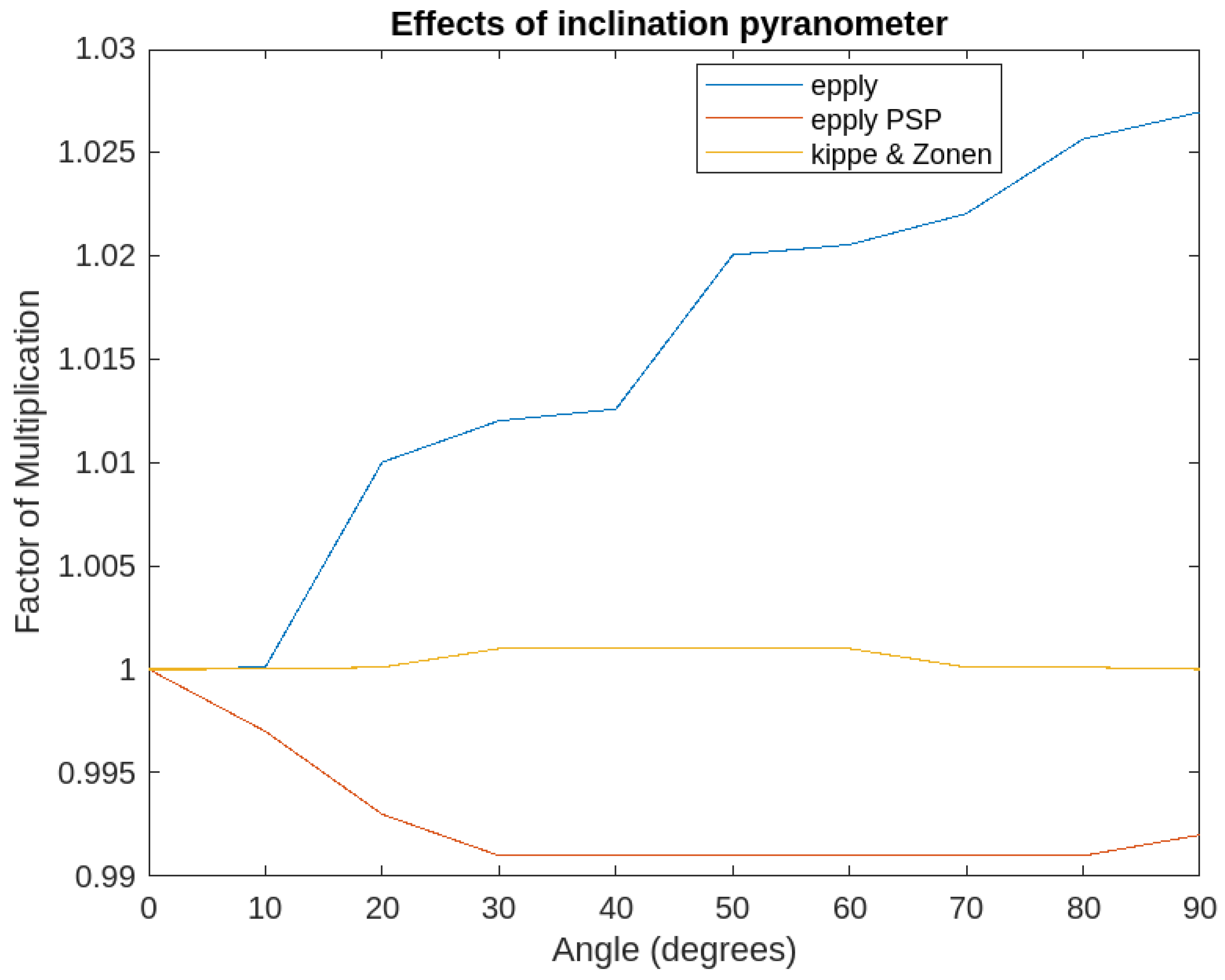

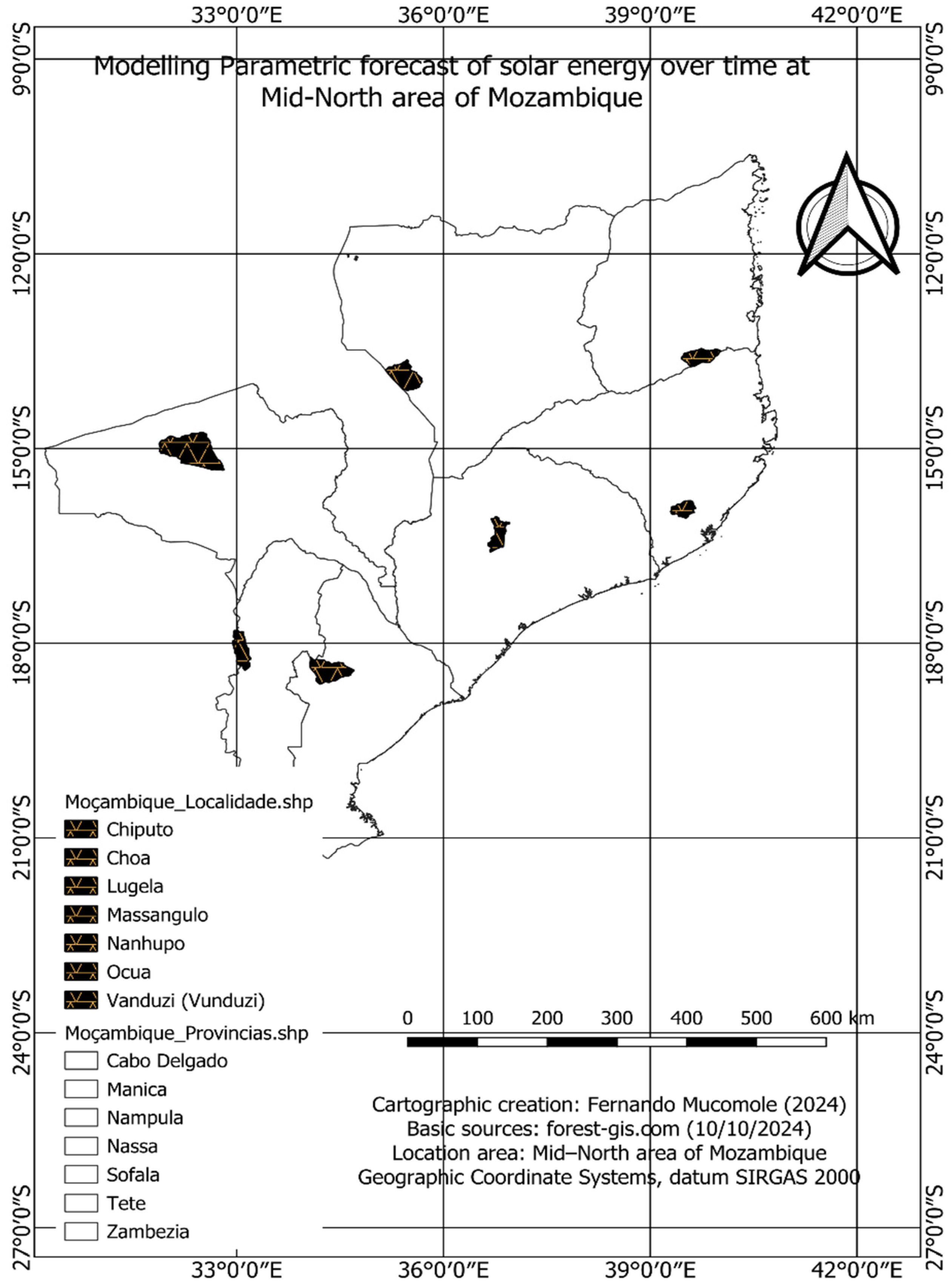
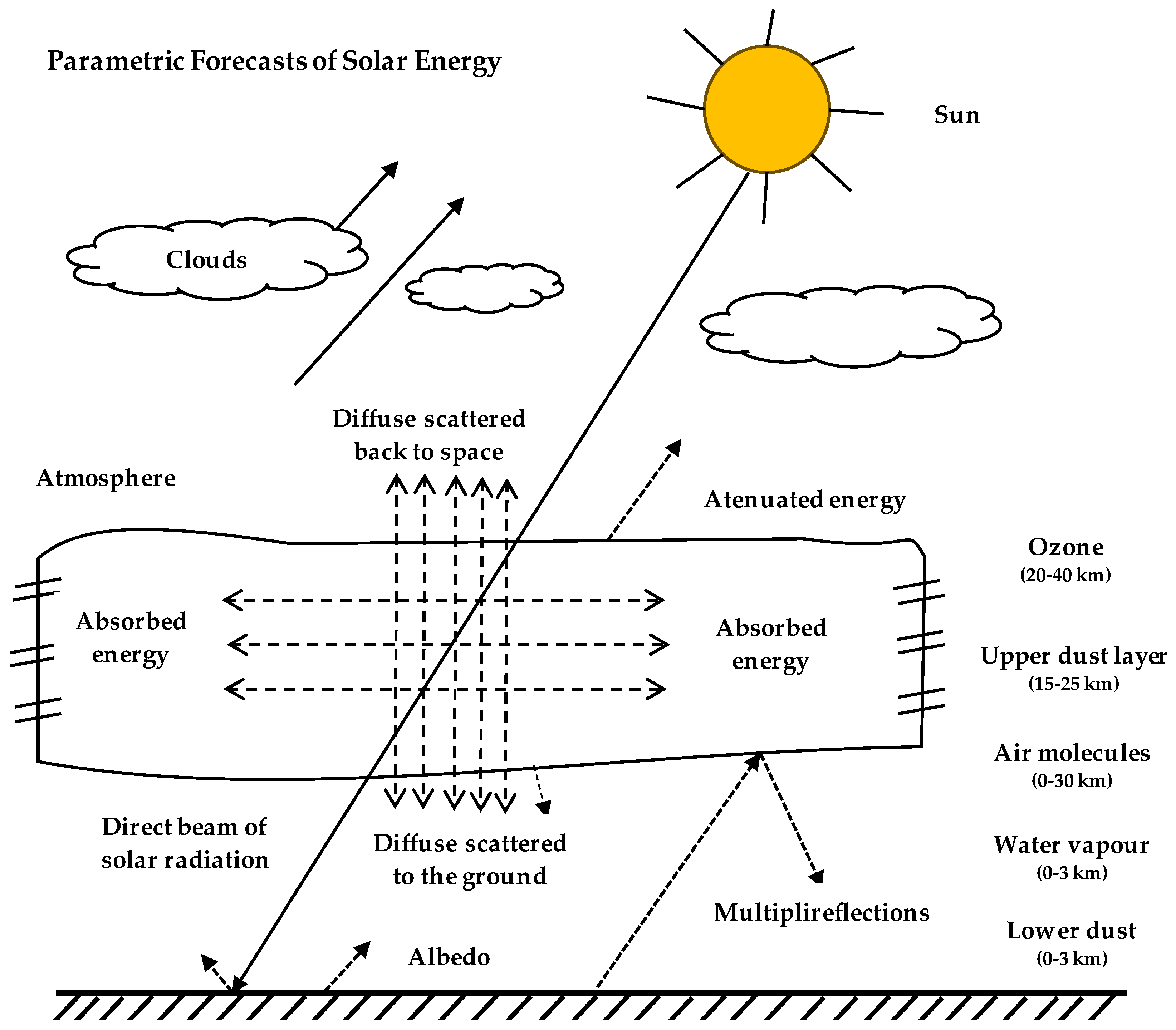
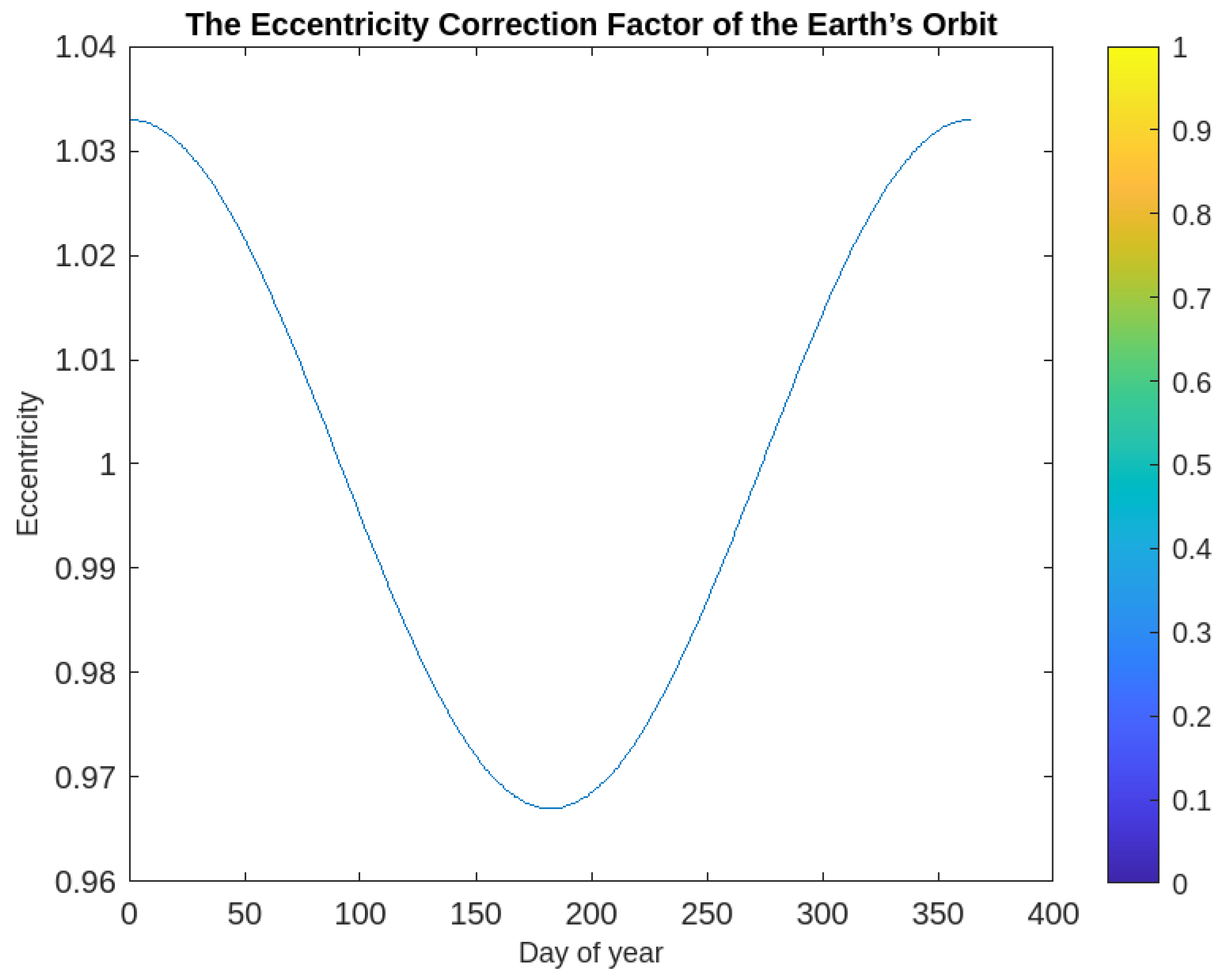




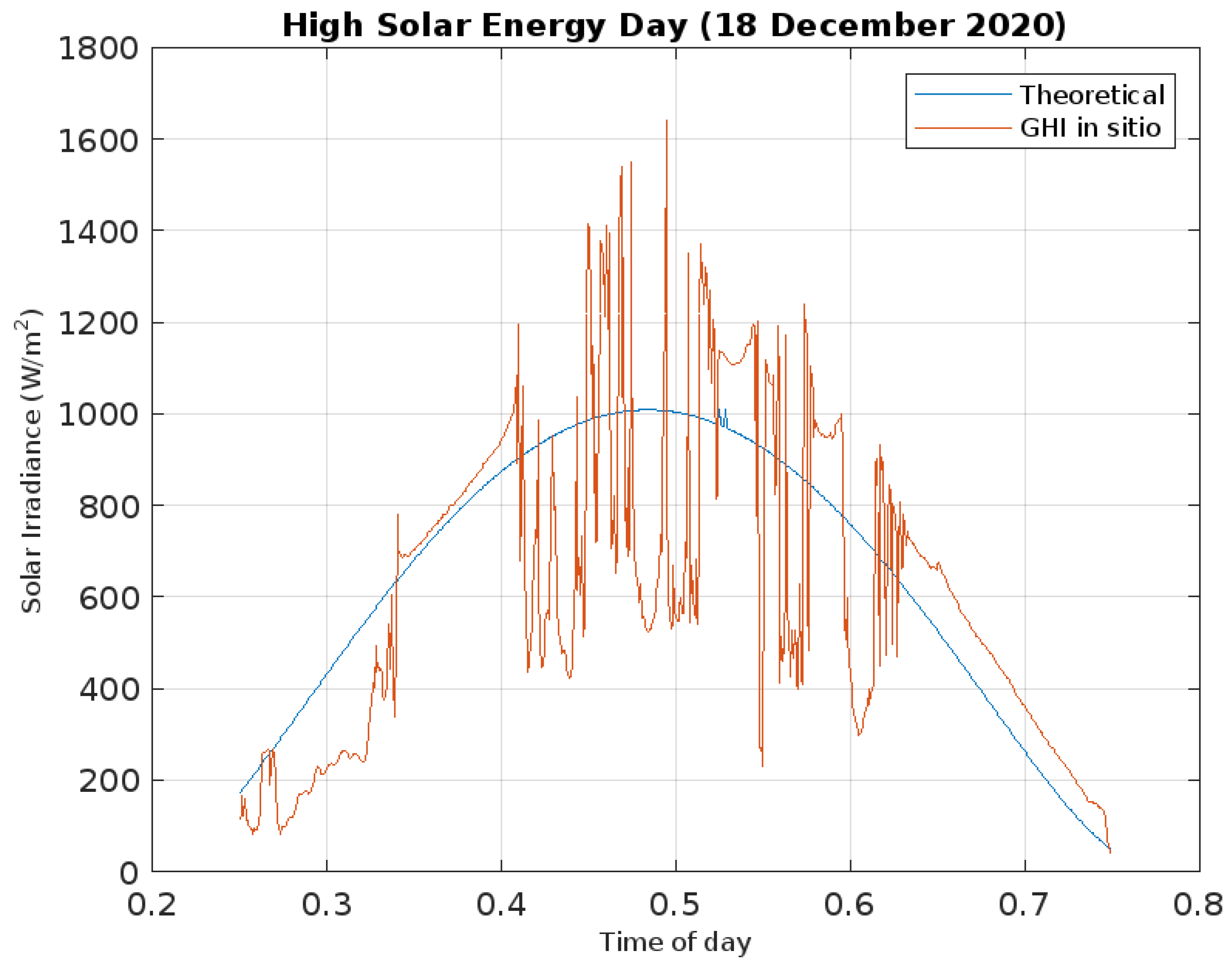
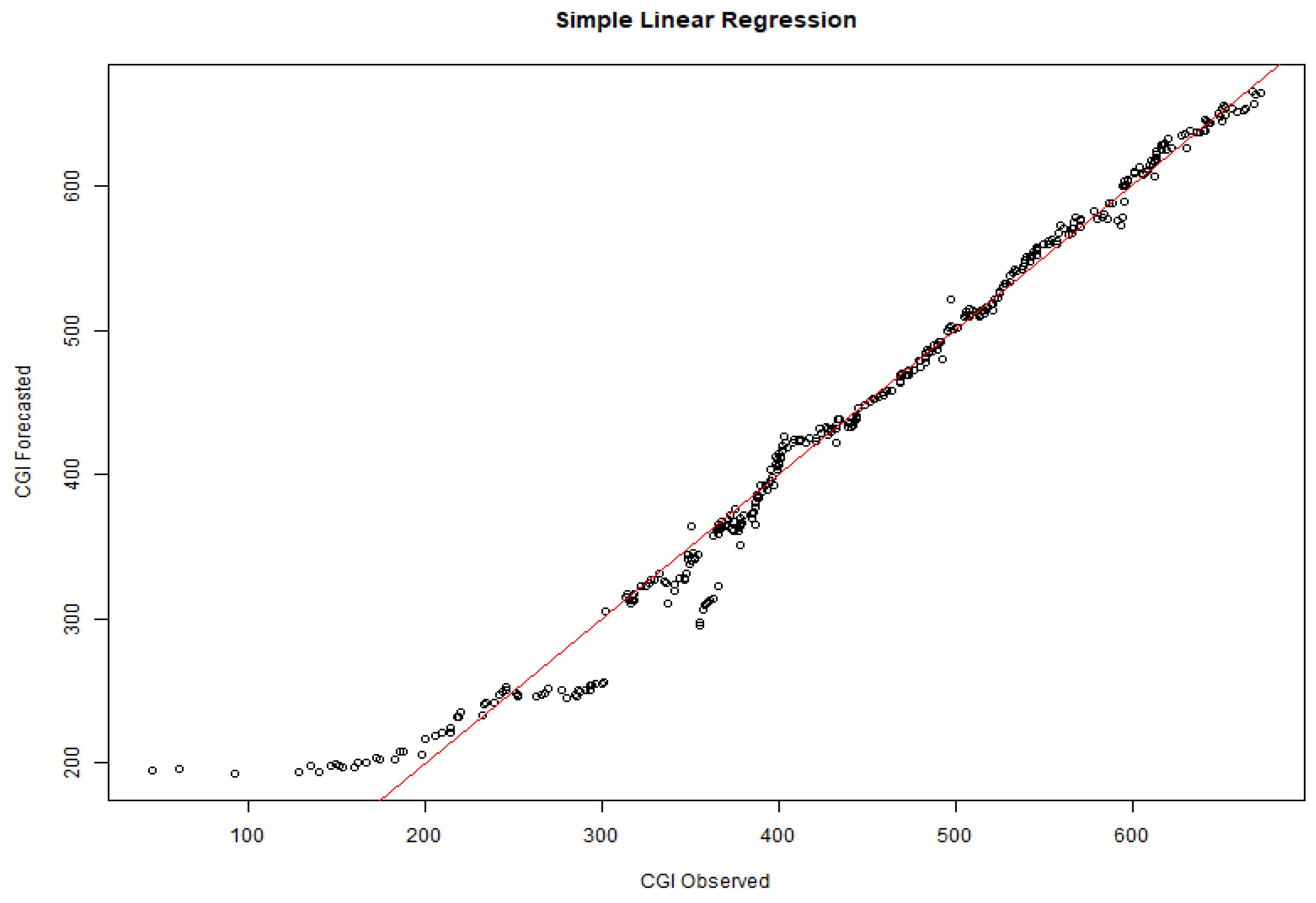
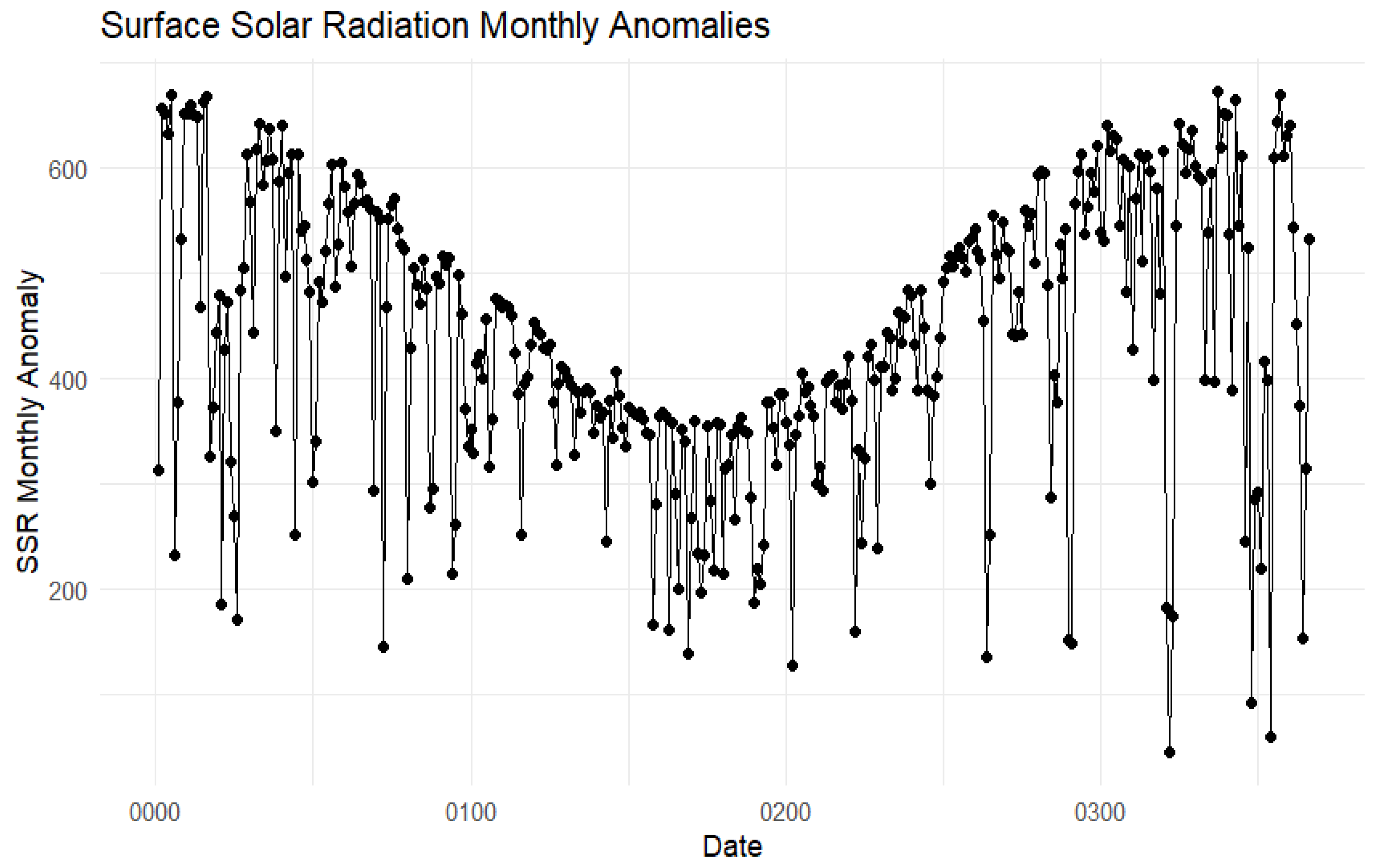
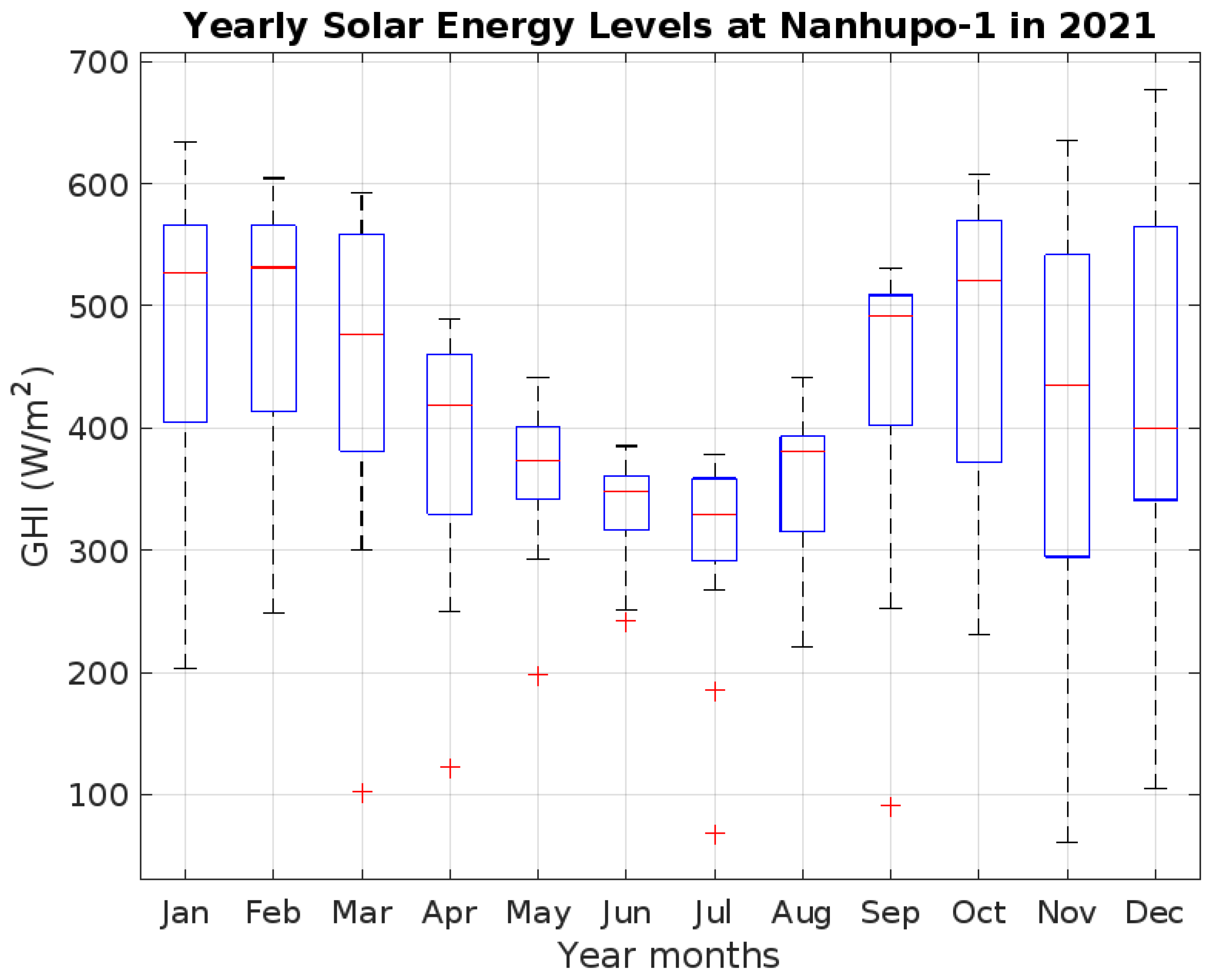
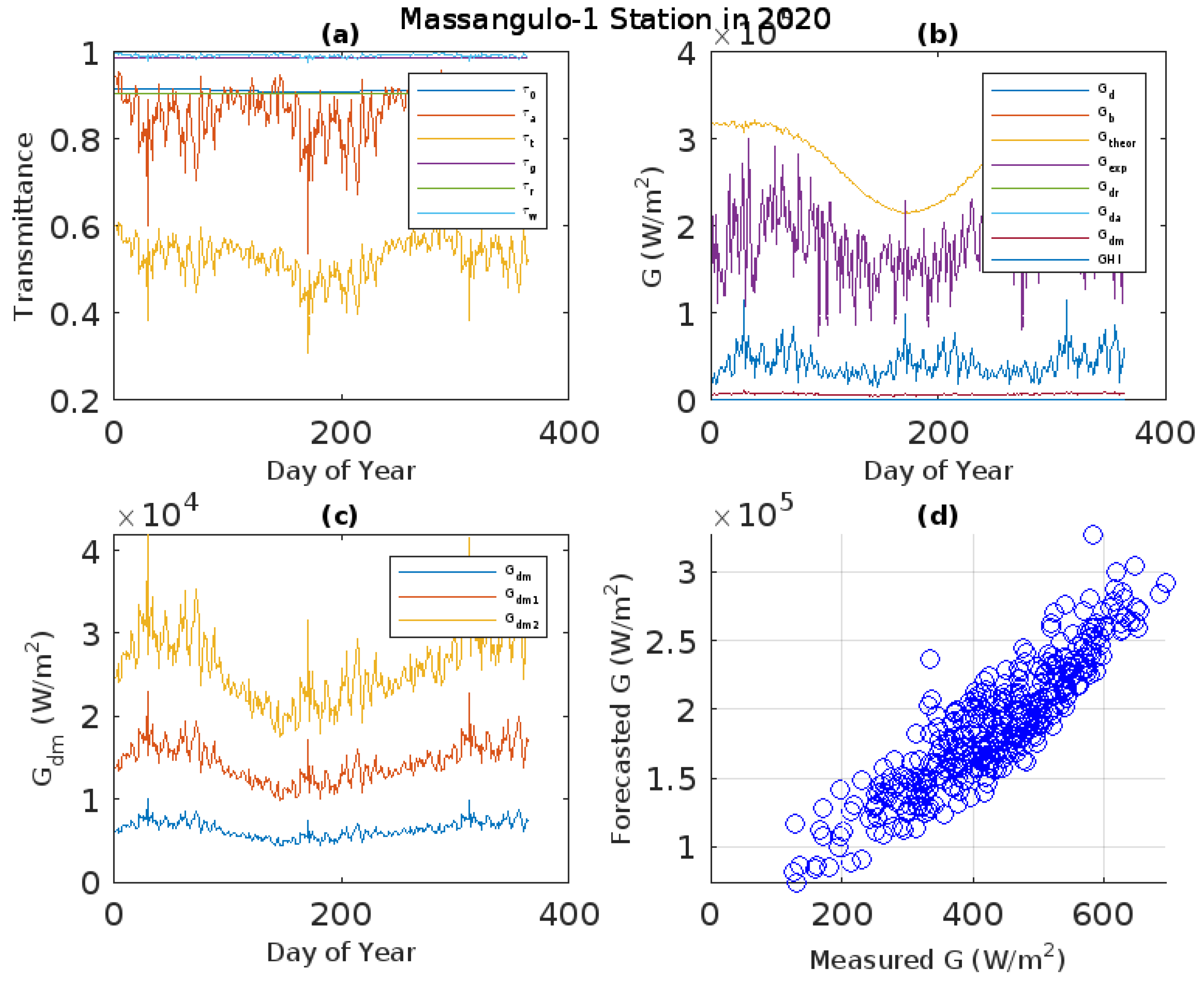
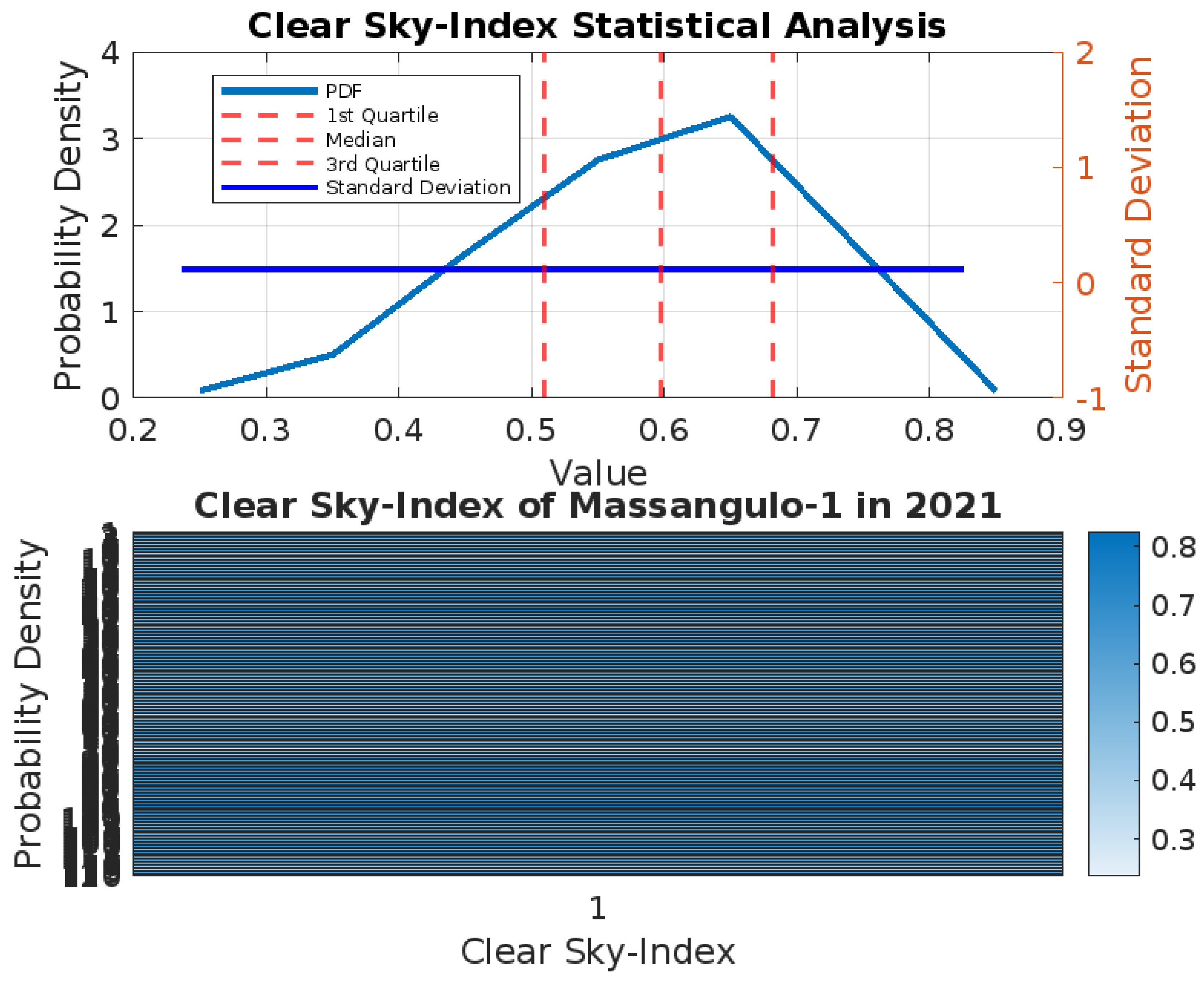

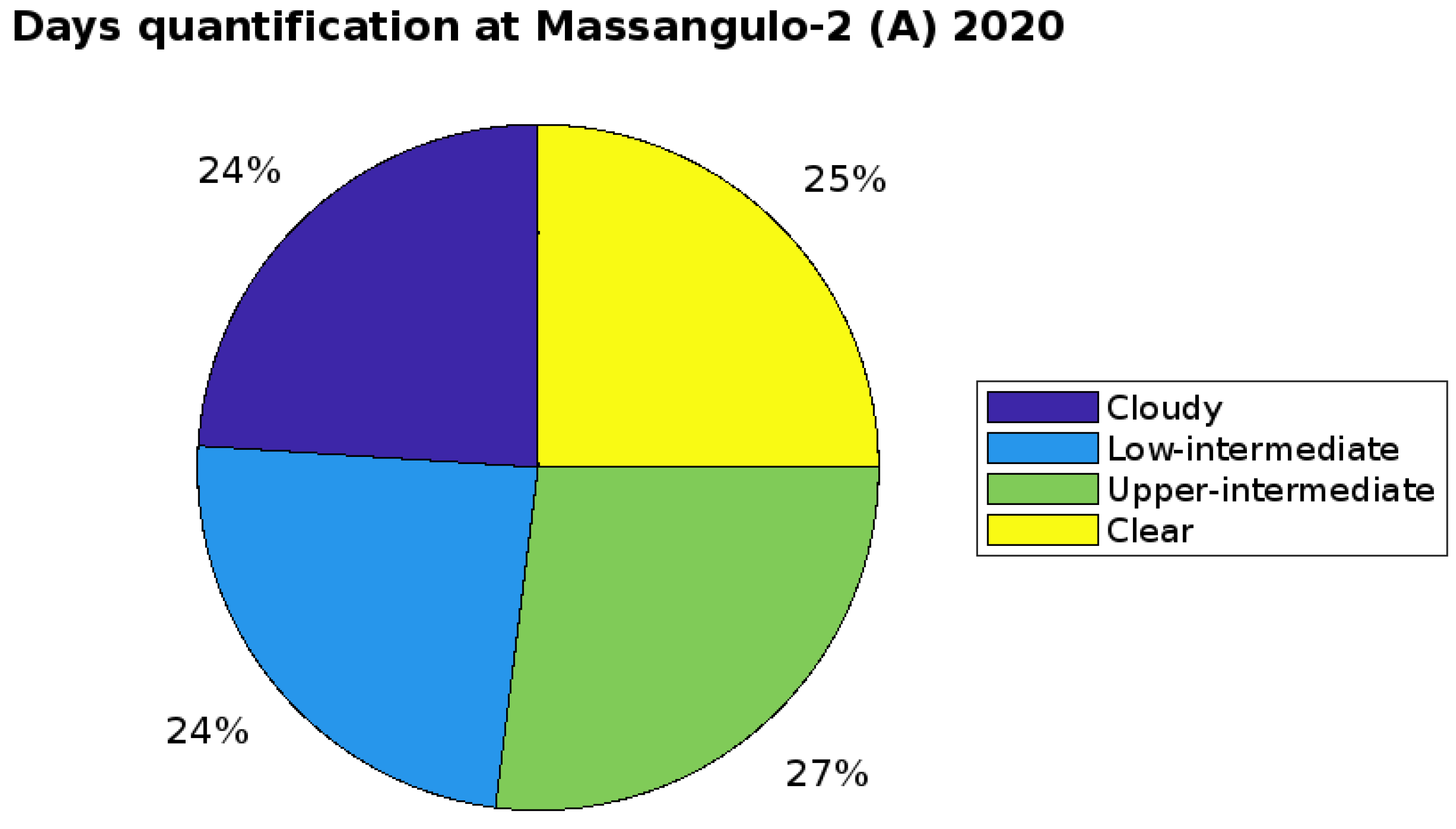
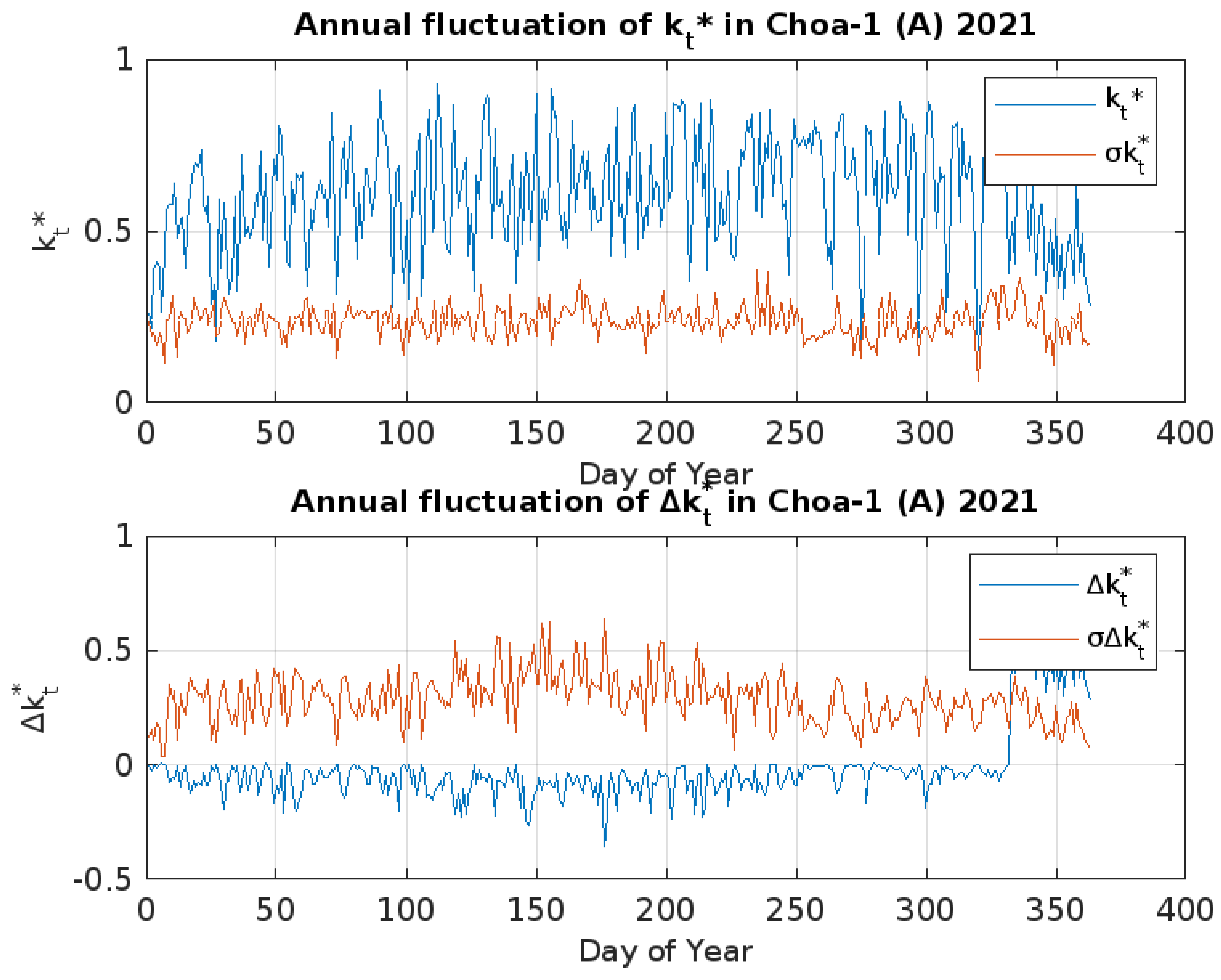
| ID | Site Name | Province | Property | λ (nm) | Amplitude | Level | Long. (°) | Lat. (°) | A (m) |
|---|---|---|---|---|---|---|---|---|---|
| 1_A | Niassa | Niassa | AERONET | 400–500 | 4″, 1 and 24 h | 2.0 | 37.5665 | −12.155 | 510 |
| 3_A | Gorongoza | Sofala | AERONET | 400–500 | 4″, 1 and 24 h | 2.0 | 37.5665 | −12.155 | 510 |
| ID | Station | Province | Tower | Code | Longitude (X) | Latitude (Y) |
|---|---|---|---|---|---|---|
| MZ03 | MZ03_Ocua | Cabo Delgado | FUNAE | TM3 | 39°23’37.17″ E | 11°32′58.09″ S |
| MZ06 | MZ06_Chiputo | Tete | FUNAE | TM6 | 31°40′40.59″ E | 14°58′29.18″ S |
| MZ11 | MZ11_Vanduzi | Sofala | FUNAE | TM11 | 35°2′21.44″ E | 19°43′47.70″ S |
| MZ21 | MZ21_Choa | Manica | MceL 1 | MCeL 14 | 33°13′10.22″ E | 17°47′33.62″ S |
| MZ24 | MZ24_Nanhupo | Nampula | MCeL 1 | MCeL 23 | 39°30′52.44″ E | 15°57′58.42″ S |
| MZ25 | MZ25_Massangulo | Niassa | TDM 2 | TDM | 35°26′13.56″ E | 13°54′28.94″ S |
| MZ32 | MZ32_Lugela | Zambezia | MceL 1 | MCeL 44 | 36°42′48.98″ E | 16°28′52.09″ S |
| Transmittance | Irradiance | ||||||||
|---|---|---|---|---|---|---|---|---|---|
| 1.000 | 0.9999 | 0.9988 | 1.00 | 0.9985 | 0.9981 | 0.8945 | 1.000 | 0.8924 | 0.9995 |
| Location | Magnitude Variability | ||||||
|---|---|---|---|---|---|---|---|
| Region | Station | Year | |||||
| Mid part | Chiputo | 2019 | 0.7132 | 0.2141 | −0.0785 | 0.2839 | 0.0504 |
| 2020 | 0.5877 | 0.2323 | −0.085 | 0.2621 | 0.2621 | ||
| Vanduzi | 2019 | 0.6839 | 0.2205 | −0.0761 | 0.2089 | 0.0547 | |
| Choa-1 | 2019 | 0.6154 | 0.2275 | −0.0898 | 0.2562 | 0.0539 | |
| 2020 | 0.6015 | 0.0898 | −0.1112 | 0.2977 | 0.1026 | ||
| 2021 | 0.6042 | 0.2367 | −0.0181 | 0.2882 | 0.0402 | ||
| Choa-2 | 2019 | 0.6025 | 0.2322 | −0.0754 | 0.2774 | 0.0326 | |
| 2020 | 0.5822 | 0.2363 | −0.06089 | 0.2705 | 0.03027 | ||
| 2021 | 0.5902 | 0.2321 | −0.0483 | 0.2581 | 0.0286 | ||
| Lugela-1 | 2019 | 0.5324 | 0.2566 | −0.0702 | 0.2263 | 0.0335 | |
| 2020 | 0.1169 | 0.2061 | −0.0731 | 0.2511 | 0.0556 | ||
| 2021 | 0.1152 | 0.2084 | −0.075 | 0.2415 | 0.06425 | ||
| Lugela-2 | 2019 | 0.5176 | 0.2535 | −0.0107 | 0.2247 | 0.0334 | |
| 2020 | 0.1185 | 0.2016 | −0.0568 | 0.2465 | 0.0605 | ||
| 2021 | 0.1124 | 0.2018 | −0.0689 | 0.2405 | 0.0636 | ||
| North part | Ocua | 2019 | 0.3073 | 0.2321 | −0.06826 | 0.2538 | 0.0503 |
| 2020 | 0.1128 | 0.2054 | −0.06396 | 0.2501 | 0.0574 | ||
| Nanhupo-1 | 2019 | 0.5407 | 0.2721 | −0.0819 | 0.2550 | 0.0295 | |
| 2020 | 0.4171 | 0.2037 | −0.0674 | 0.2384 | 0.0647 | ||
| 2021 | 0.1186 | 0.2016 | −0.0646 | 0.2479 | 0.0532 | ||
| Nanhupo-2 | 2019 | 0.4917 | 0.2694 | −0.0577 | 0.2483 | 0.02102 | |
| 2020 | 0.1398 | 0.2078 | −0.0712 | 0.2078 | 0.0589 | ||
| 2021 | 0.1059 | 0.1948 | −0.5656 | 0.2328 | 0.0667 | ||
| Massangulo-1 | 2019 | 0.5615 | 0.2566 | −0.2778 | 0.2778 | 0.0422 | |
| 2020 | 0.1059 | 0.1948 | −0.5656 | 0.2328 | 0.0667 | ||
| 2021 | 0.5621 | 0.2490 | −0.1302 | 0.2854 | 0.0451 | ||
| Massangulo-2 | 2019 | 0.5808 | 0.2551 | −0.06156 | 0.2518 | 0.0283 | |
| 2020 | 0.5605 | 0.2484 | −0.0588 | 0.2502 | 0.5001 | ||
| 2021 | 0.4106 | 0.2488 | −0.0561 | 0.1889 | 0.0215 | ||
Disclaimer/Publisher’s Note: The statements, opinions and data contained in all publications are solely those of the individual author(s) and contributor(s) and not of MDPI and/or the editor(s). MDPI and/or the editor(s) disclaim responsibility for any injury to people or property resulting from any ideas, methods, instructions or products referred to in the content. |
© 2025 by the authors. Licensee MDPI, Basel, Switzerland. This article is an open access article distributed under the terms and conditions of the Creative Commons Attribution (CC BY) license (https://creativecommons.org/licenses/by/4.0/).
Share and Cite
Mucomole, F.V.; Silva, C.A.S.; Magaia, L.L. Modeling Parametric Forecasts of Solar Energy over Time in the Mid-North Area of Mozambique. Energies 2025, 18, 1469. https://doi.org/10.3390/en18061469
Mucomole FV, Silva CAS, Magaia LL. Modeling Parametric Forecasts of Solar Energy over Time in the Mid-North Area of Mozambique. Energies. 2025; 18(6):1469. https://doi.org/10.3390/en18061469
Chicago/Turabian StyleMucomole, Fernando Venâncio, Carlos Augusto Santos Silva, and Lourenço Lázaro Magaia. 2025. "Modeling Parametric Forecasts of Solar Energy over Time in the Mid-North Area of Mozambique" Energies 18, no. 6: 1469. https://doi.org/10.3390/en18061469
APA StyleMucomole, F. V., Silva, C. A. S., & Magaia, L. L. (2025). Modeling Parametric Forecasts of Solar Energy over Time in the Mid-North Area of Mozambique. Energies, 18(6), 1469. https://doi.org/10.3390/en18061469







